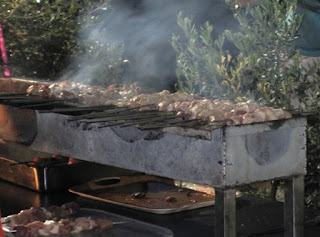 |
| framed by the ruins of Paphos |
In 1962, a farmer ploughing his field near the harbour in Paphos
stumbled upon the most amazing treasure.
Not far under the earth’s surface lay entire mosaic floors of a complex
of Roman houses dating from the first century AD.
 |
| the tree of life - Paphos |
They had remained buried since an earthquake
had razed the area in the second century.
The excavations and the findings, including a Roman theatre,
were extensive; and resulted in the city setting aside a vast tract of land, along
the sea-side, which has now been saved from the developers. Some of the floor
mosaics remain outside and you walk around them , and in some cases, on top of
them, while others, the more intricate of them, are housed in a large building
with cat walks taking you over and along-side these works of art.
 |
| outdoor mosaic - Paphos |
In some large outdoor areas, there are rough pebble mosaics,
which are attractive enough in themselves, but most of the mosaics are formed
from tiny pieces of cut stone. For the more intricate designs, glass has been
hand-painted to produce the required colours. Undoubtedly, the mosaics which
depict scenes and characters from Roman mythology are deemed to be the most
outstanding.
 |
| outdoor mosaic - Paphos |
However, if I were the Roman lady of the manor, I would
prefer to have geometric patterns as the floors of my house rather than scenes of
cavorting gods and goddesses and the ever -present, naked Cupid shooting his
arrows at one or the other of them.
 |
| Cupid at work |
In one beautiful, geometric floor in the House of Dionysius,
I spied two interesting motifs, side by each. Back in the first century, it
seems that the swastika and the Star of David shared a peaceful co-existence on
the floor of a wealthy Roman in Cyprus.
 |
| the ancients had it right - peaceful co-existence |
I have seen the swastika emblem used in India
as a peaceful Buddhist motif, but I didn’t know it had travelled to the
Mediterranean by the first century. Of course the Star of David must have been
known in 100 AD but it is interesting that they are found as mates on this
mosaic floor. Now why didn’t Hitler know of this? Perhaps some scholarly study
of antiquities might have prevented the genocide of the Second World War. But
of course the floor only came to light in the 1960s. When you know the recent
history, it does send a shiver down your spine when you see that nearly 2000
years ago, a swastika was portrayed next to a Star of David on the floor of a
Roman consul in Cyprus.
 |
| St Paul's pillar and Ayia Kyriaki - Paphos |
There are no Christian symbols in these mosaics despite the
fact that Paul and Barnabas came to Cyprus in 44 AD and reputedly converted
this very same Roman governor to Christianity. The books like to say that
Cyprus was the first Christian country because it was ruled by this converted
Roman consul.
Of course that didn’t stop other influential people in
Cyprus for punishing Paul for trying to convert the populace. There still
stands a Roman column near the ruins of an old Christian basilica, replaced by
a still-standing Byzantine church. It is called St Paul’s pillar for here Paul
was whipped for practicing and preaching his faith.
 |
| Zeus helped by Cupid in a seduction attempt |
There are also beautiful mosaics in other archaeological sites
throughout Cyprus but none are as beautiful as those found in Paphos.




























